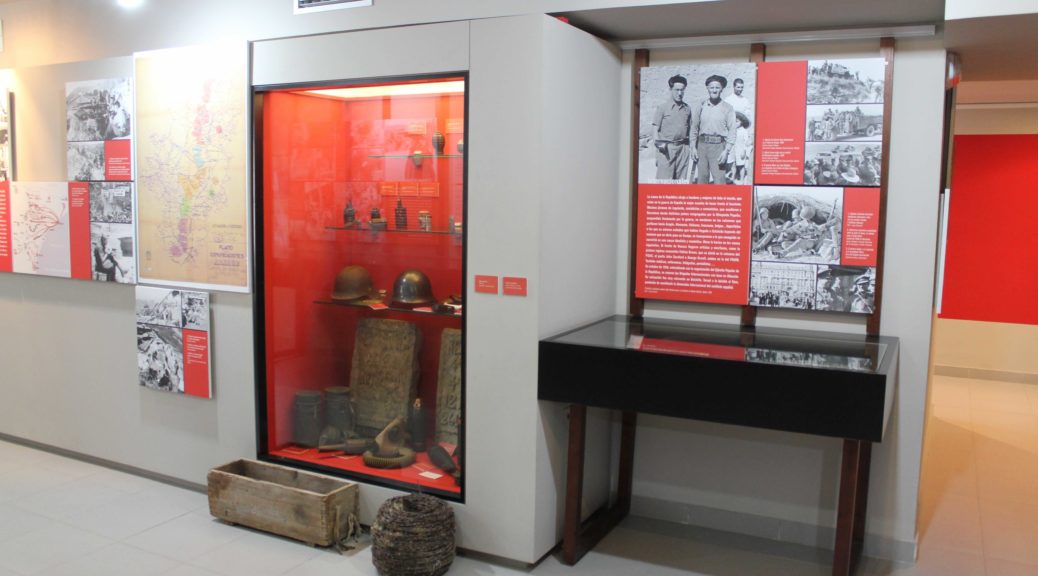In recent years there has been a growth of small museums in Spain dedicated to the Civil War. One of the earliest of these is in the Aragonese village of Robres. Charlie Nurse has visited the museum, along with Nick Lloyd, who runs Spanish Civil War tours in Barcelona. Here are some of his impressions
At first sight, Robres seems an unlikely place to find the Centro de Interpretación y Estudios de la Guerra Civil en Aragón – the provincial capitals of Zaragoza, Huesca or Teruel would appear more likely candidates. While it is more difficult to reach than these cities without a car, the museum is well worth the detour for visitors with a knowledge of Spanish. Though small, it provides a comprehensive account of the war in Aragón as well as detailing its immediate background and its consequences.
The war in Aragón is usually seen, understandably, as a side-show of little importance during the first year of the war. Yet, for example, the success of the coup of July 1936 in Zaragoza and the repression in the city which followed was of great strategic importance in the early weeks of the conflict, blocking loyalist forces in Catalonia from supporting their beleaguered allies in the Basque provinces.
The museum displays a range of items from the period including newspapers, military equipment and medical supplies. Introductory panels highlight some of the figures who played prominent wartime roles in the region such as General Miguel Cabanellas, who led the successful coup in Zaragoza and the Anarchist leader Buenaventura Durruti. The background to the war is provided by a section on the Second Republic which focusses on the important social changes it brought to Aragón, particularly in the provision of schools and the changed status of women.
The coup is illustrated by contemporary newspaper accounts and there is detailed coverage of the violence which erupted in the region, both in the zone which came under military rule and in that which remained under the Republic. The centrepiece of this part of the museum is undoubtedly the large mural which integrates the names of those people killed in the region by the rebel forces during the war and in the early years of the Franco regime.

This is the work of Victor Pardo Lancina, a local historian, who points out that, although the mural includes 8,913 names, recent research means that, if it were made today the total number of names would be over 10,000. Pardo is also the designer of the Ruta George Orwell, which provides guidance on Civil War locations in the region.
In the early days after the coup the region was divided between western Aragón, under rebel forces based in Zaragoza, and eastern Aragón, under the militia forces which advanced from Barcelona and Valencia. Despite the attempt of Republican armies to capture Zaragoza in the autumn of 1937, the front shifted little until the great Republican assault on Teruel in December 1937 and the major offensive launched by Franco’s forces and their Italian and German allies in the spring of 1938. An excellent detailed map illustrates the division of the region in 1936-37 and enables the visitor to identify the different sectors of the front held by the various Republican militias.
Subsequent sections include material on the arrival of the militias in rural eastern Aragón in 1936 and the extraordinary experiment which followed, with the collectivisation of agriculture and the establishment of the anarchist-led Council of Aragón. The stark contrasts between eastern and western Aragón are highlighted by sections which examine aspects of everyday life in the two zones, including schooling and the roles played by women. The final sections cover the post-war period: what is particularly notable is the difference between the triumphalist Francoist propaganda material exhibited and the picture provided of the reality of repression and exile.
Opened in 2006, at the same time as the inauguration of the Ruta George Orwell, the museum enjoys financial support from a local government consortium. Despite their relatively isolated location, both the museum and the Ruta are attracting increased attention. In the first six months of 2023, the museum received over 1,500 visitors, higher than for the whole of 2022. There has been a notable growth in visitors from France and especially of student groups. Nick Lloyd comments:
There must be more than 50 small museums, often called Centres of Information, across Spain, dedicated to different aspects of the Civil War. I certainly haven’t even visited half of them, but Robres, along with the Exile Museum in La Jonquera on the Catalan-French frontier, is my personal favourite. It’s a great little place.
The Centro de Interpretación y Estudios de la Guerra Civil en Aragón is open at weekends only: Saturdays 11.00-14.00 and 16:30-18.30; Sundays 11.00-14.00 all year round (hours may differ from July to September). Entry: 2 euros, reduced rates for unwaged and for group visits. Further details: turismo@monegros.net or their website For guided visits phone 34-974-570-090.
Note: Victor Pardo is also the author of the book Todos los nombres. Víctimas y victimarios (Huesca 1936-1945), together with Raúl Mateo Otal. It is a biographical dictionary listing all the casualties in the town of Huesca as a result of repression after the coup d’etat on 18 July 1936. The data is included in our database. Read the description here.
PHOTO: Museum room. Courtesy of Centro de Interpretación y Estudios de la Guerra Civil en Aragón.
